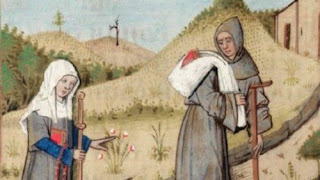For Phlegm take –Sugar candy, sugar plate*, sugar withAniseed, fennel seed, nutmeg, cinnamon,Ginger [...] and licorice. Beat themtogether in a mortar and make them in allmanner of food and drinks and dry first and last eat it.
The "For Phlegm" seems clear: this is a recipe for dragges, a sweet mixture intended to be medicinal. At one point in her life, Margery came down with the "flux"; this was probably dysentery. She was so ill that a priest was summoned to give her Last Rites because she feared she was near death. Dragges was intended to be a cure for many ills. A well-meaning scribe may have decided to add this recipe to help people avoid her illness in the future.
There is another credible theory, however, put forth in 2018 by Laura Kalas.
Dr. Kalas' argument is that the reason for the existence of this particular confection becomes clear when you look at the references to "sweetness" in her writing (and the writings of other mystics). Besides her conversations with God, she describes the sensations she experiences during her mystic episodes, which include sensations of sweetness. She asks God how she might make her love of God as swet to þe as me thynkyth þat thy loue is vn-to me ("as sweet to you as I think your love is to me"). She describes her experience with God as "sweet dalliance."
As a recipe for digestive dragges, or dragées, it is rich with sugar and spice, suggesting a wealthy site of monastic holiness and health. It thus offers a lens through which to explore the sweetness of confection and divine love in the Book. The hot spices, used to correct a cold and moist physiological constitution, are at the same time a means of stoking the hot fire of love that is played out in the Book. But the recipe imbues more than metaphorical signification. In the Middle Ages, the moral properties of food were imbricated with its ingestion. In consuming a foodstuff, one would take on some of its associated properties (the Eucharistic wafer as an obvious example). [Link to her article]
So...recipe for flux/phlegm, or reminder of the sweetness connected to spiritual revelation? In a nod to social media memes, "why not both?"
Now I'm thinking of sweet things, and since we are on the leading edge of the holiday season (some would say we are fully embroiled in it), let's look at some sweet medieval recipes for holiday entertaining...next time.
*"sugar plate" was a moldable form of sugar paste. I found an Elizabethan recipe here.




